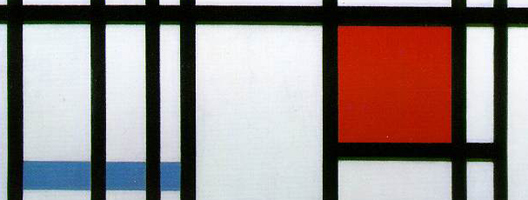Mondrian's strict formal contrictions made him grow dissatisfied with
the Cubist movement. He agreed with their attempts to abstract the geometrical
from reality, but was dissatisfied with their insistence on using realistic
objects in their abstraction. He thought that the Cubists were failing
to carry their ideology to its logical conclusion - absolute abstraction
and pure geometry without any realistic representation. By 1914, Mondrian
had eliminated all realism from his work. His painings ar this time consisted
mostly of straight lines with a few curves interspersed. Although he used
mainly rectangular canvases, he sometimes made ovular and circular borders
within which his highly stylized geometrical world could exist. By 1916,
however, Mondrian stopped using curves in his paintings, claiming, "The
flowing line of things in nature entails a slackening of form." From
then on, all of his paintings were composed using only vertical and horizontal
lines. We should not think, however, that Mondrian's work was so abstract
that it cam wholly from his mind. He generated many of this works from direct
contemplation or real phenomena (landscapes, cityscapes) and painted lines
on the canvas that he thought represented the inherent balance in the beautiful
scene he was trying to represent.
Although there are many lovers of Mondrian's work, it has always been
controversial. Many view it as bereft of feeling, but as we have seen from
the above quotation, this was Mondrian's goal. He hoped to asymptotically
represent the "objective". At the same time, some critics have
accused him of not representing anything at all, and that his lack of representation
made his rectangular forms hard to grasp. He, of course, was convinced
otherwise. H wrote, "since the male principle is the vertical line,
a man shall recognize this element in the ascendig trees of the forest;
he sees his complement in the horizontal line of the sea. The woman, with
the horizontal line as characteristic element, recognizes herself in the
recumbant lines of the sea and sees herself complemented in the vertical
lines of the forest."
Although we may find even his verbal argumentation obtuse, he was convinced
that his abstract representation of "pure" reality through geometry
of rectangles was valuable, if not the only wat to make true art. He spent
almost thirty years, from c. 1916 until his death in 1944 pursuing this
form. He left behind him a vast collection of work, the overwhelming majority
filled with rectangles, and only rectangles.

